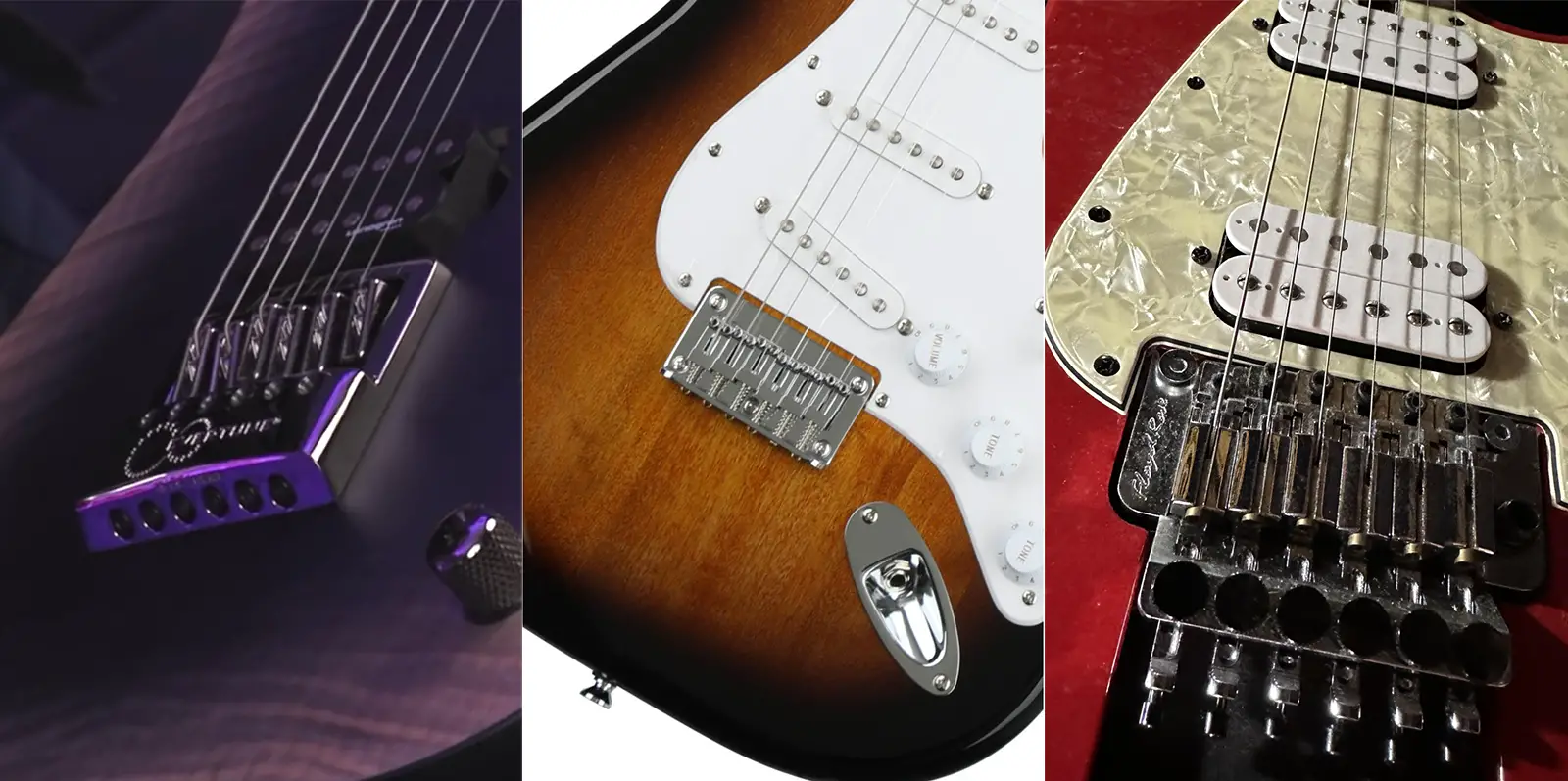From the casual observer’s point of view, a guitar may seem like a relatively simple instrument.
However, every guitarist knows that each component plays a vital role in shaping the sound, playability, and overall functionality of the instrument.
One such essential part is the guitar bridge, a seemingly inconspicuous piece of hardware that holds a world of influence over a guitar’s performance.
What is a Guitar Bridge?
A guitar bridge is a component of the instrument that supports the strings, transfers their vibrations to the soundboard or body, helps maintain tuning stability, and allows for adjustment of string action (height from the fretboard). It comes in various designs, each offering different features and performance characteristics.
The guitar bridge serves multiple critical functions, including supporting the strings, maintaining tuning stability, transferring vibrations, and adjusting string action.
It comes in a myriad of designs, from the simple yet efficient hardtail to the complex and versatile Floyd Rose tremolo system, each offering unique benefits and drawbacks.
In this article, we examine the world of guitar bridges, exploring their importance, the different types available, and the impact they have on your playing experience.
Whether you’re a budding guitar enthusiast or a seasoned musician looking to optimize your instrument’s performance, understanding the role of the guitar bridge can provide valuable insights into your musical journey.
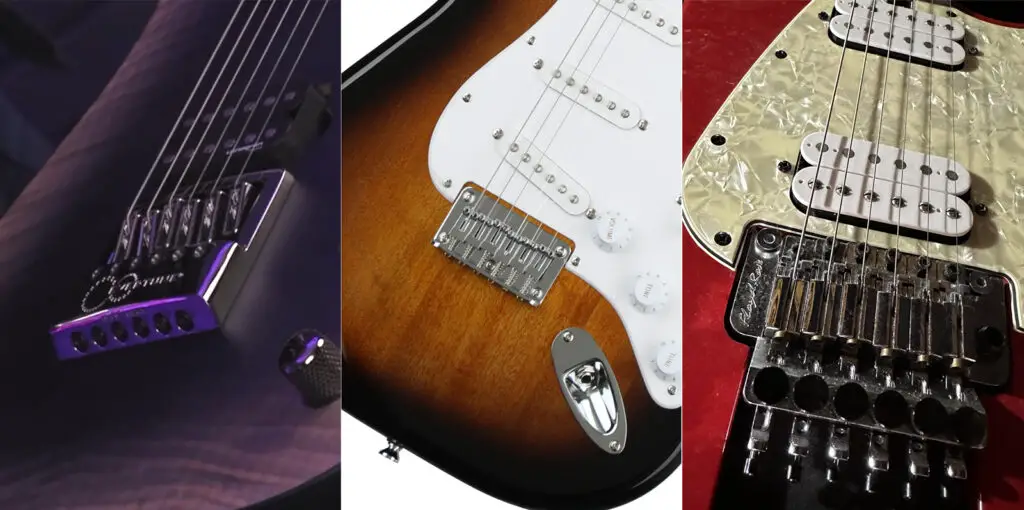
What Is A Guitar Bridge?
A guitar bridge is a critical component of the instrument’s construction that serves several important functions:
- Anchoring the Strings: The bridge is where the strings of the guitar are anchored to the body of the guitar. This is done either directly or indirectly through another component called the tailpiece, depending on the type of guitar.
- Transmitting Vibrations: When you pluck a string, it creates vibrations. The bridge helps transmit these vibrations from the strings to the body of the guitar, which then resonates to produce sound. This is particularly important in acoustic guitars but is also relevant in electric guitars, where the vibrations are converted into an electric signal by the pickups.
- Adjusting String Action: The bridge often has a role in determining the ‘action’ of the guitar – that is, the height of the strings above the fretboard. This can greatly affect both the playability of the guitar and the intonation (i.e., whether the guitar stays in tune across the length of the fretboard).
- Adjusting Intonation: Many bridges allow for the adjustment of the intonation of the guitar. By moving the bridge saddles (the point where the string actually contacts the bridge) forward or backward, you can adjust the effective length of the string, which helps ensure that the guitar sounds in tune up and down the neck.
- Providing a Rest for the Hand or Palm: The bridge is also often used as a rest for the picking hand or palm while playing, particularly in styles that involve palm muting.
There are various types of guitar bridges, such as Tune-O-Matic, Floyd Rose, and Telecaster-style bridges for electric guitars, and pin-style bridges for acoustic guitars. Each has its own unique design and characteristics, but they all serve these essential functions.
Guitar Bridge Types
Here is a list of common guitar bridge types:
- Tune-O-Matic Bridge: Introduced by Gibson in the mid-1950s, the Tune-O-Matic bridge is one of the most widely used bridges on electric guitars. It allows individual adjustment of each string’s length (for intonation) and height (for action).
- Floyd Rose Bridge: The Floyd Rose bridge is a type of locking vibrato bridge, or “tremolo” bridge. It allows the player to change the pitch of notes or chords using a lever, also known as a “whammy bar,” while maintaining tuning stability.
- Fender Stratocaster Tremolo Bridge: This is another type of vibrato bridge commonly found on Fender Stratocasters. Unlike the Floyd Rose, it doesn’t have a locking system but still allows pitch manipulation via a whammy bar.
- Telecaster-Style Bridge: Traditional Telecaster-style bridges have three adjustable saddles that hold two strings each. Modern versions often have six saddles for more precise intonation adjustment.
- Hardtail Bridge: A hardtail bridge is a non-vibrato type of electric guitar bridge, which is simply a bridge that doesn’t move. This type of bridge is often found on many solid body guitars.
- Bigsby Vibrato Tailpiece: A Bigsby is a type of vibrato device that sits on top of the guitar body and allows the player to subtly change the pitch of notes or chords.
- Acoustic Guitar Bridges:
- Pin Bridge: This is the most common type of bridge for steel-string acoustic guitars. It uses removable pins to hold the strings in place.
- Classical or Tie Block Bridge: This is found on nylon-string classical and flamenco guitars. The strings are tied to the bridge.
- Archtop Guitar Bridge: This bridge is found on archtop guitars, both acoustic and electric. It is typically a wooden bridge that can be adjusted for height.
- Resonator Guitar Bridge: Resonator guitars have a unique bridge assembly that transmits string vibrations to a resonator cone, which amplifies the sound.
These are just some of the many types of guitar bridges. Each type offers different functionality, playability, and tonal characteristics.
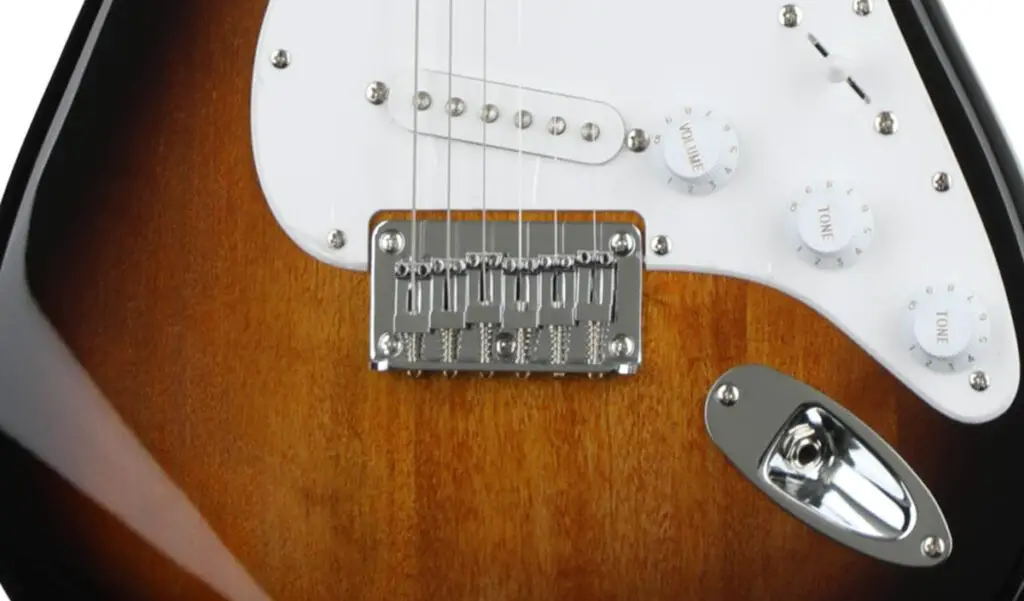
What Is A Fixed Bridge Guitar?
A fixed bridge guitar is a type of guitar where the bridge is securely fastened to the body of the guitar and does not move. This is contrasted with floating or tremolo bridges, which can be moved using a lever or “whammy bar” to alter the pitch of the strings.
Fixed bridge guitars are valued for their tuning stability and sustain. Because the bridge doesn’t move, the guitar is less likely to go out of tune, which is a common problem with some types of floating bridges. This makes fixed bridge guitars a popular choice for beginners who may not yet know how to properly use or maintain a tremolo bridge.
The hardtail bridge and the Tune-O-Matic bridge with a stopbar tailpiece are examples of fixed bridges. They are commonly found on many models of electric guitars, including many Gibson Les Pauls and Fender Telecasters. Fixed bridges are also standard on acoustic guitars, with the pin bridge being the most common type.
The term “fixed bridge” can be used to refer to any guitar bridge that doesn’t have a tremolo, including those on acoustic and classical guitars.

What Is An Evertune Bridge?
The EverTune bridge is a product of an American company, EverTune, designed to keep guitar strings in tune. It was created as a response to the tendency of stringed instruments, particularly guitars, to get out of tune during playing, especially when strings are bent.
The EverTune bridge was developed by guitarist and engineering student Cosmos Lyles and engineer Paul Dowd. The prototype uses a spring and lever system that maintains string tension, keeping the guitar in tune.
The EverTune bridge keeps a guitar in tune despite changes in tension. This mechanical device maintains a constant state of tension, regardless of changes in temperature, humidity, or pressure exerted on the string.
On a guitar, the EverTune bridge has six springs and levers, one for each of the guitar’s six strings. When a string stretches or slips, the springs apply the opposing force necessary to compensate for the shift, thus maintaining the correct tension and tuning.
The mechanism has been patented, and a guitar with one installed is tuned differently than traditional guitars. Instead of tuning by solely turning the pegs at the end of the guitar’s neck, the EverTune bridge is tuned with a screw on the bridge itself.
More information about the EverTune bridge can be found in the Wiki Article
What Is A Floyd Rose Bridge?
The Floyd Rose bridge is a type of locking vibrato system, often referred to as a “tremolo” bridge, for the electric guitar. This system was invented in 1976 by Floyd D. Rose. It’s known for its ability to keep the guitar in tune even after extreme pitch bends.
The key components of a Floyd Rose bridge include:
- Locking Nut: This is used at the top of the guitar neck to completely lock the strings in place. This helps prevent the strings from moving around in the nut and going out of tune, a common problem with traditional tremolo systems.
- Fine Tuners: These are located on the bridge itself and allow for precise tuning adjustments after the nut has been locked.
- Floating Bridge: The Floyd Rose bridge is a type of floating bridge, meaning it is balanced on a pivot point and can move up and down. This allows the player to change the pitch of the strings in both directions (up and down) using the attached tremolo arm or “whammy bar.”
- Double-Locking System: The combination of the locking nut and the bridge that locks the string ends forms the double-locking system, offering superior tuning stability compared to non-locking systems.
While the Floyd Rose bridge allows for extreme pitch manipulation and maintains tuning stability, it also makes string changes and tuning adjustments more complex than with traditional bridge systems.
As a result, it’s most commonly found on electric guitars intended for styles of music where heavy use of pitch bending and vibrato are common, such as heavy metal and shred guitar styles.
What Is A Tremolo Bridge?
A tremolo bridge, also referred to as a “vibrato bridge,” is a type of bridge on a guitar that allows the player to temporarily change the pitch of the strings by manipulating a lever, or arm.
When the arm is pushed down, it lowers the pitch, and when it’s pulled up, it raises the pitch.
The lever attached to the bridge can go by several names: tremolo arm, tremolo bar, whammy bar, or wang bar. The most common name is a whammy bar.
Despite its name, a “tremolo” bridge actually produces vibrato (a variation in pitch), not tremolo (a variation in volume). The misnomer comes from early Fender Stratocasters, which incorrectly labeled their vibrato systems as “synchronized tremolo.” Source: Guitar Effects Pedals (Amazon)

There are several types of tremolo bridges, including:
- Fender Synchronized Tremolo: Introduced on the Fender Stratocaster, this type of tremolo allows pitch bending in both directions but is most effective for pitch lowering. It uses a set of springs in the back of the guitar to balance the tension of the strings.
- Floyd Rose Tremolo: This is a more complex system that locks the strings at both the bridge and the nut to provide more tuning stability even with heavy tremolo use. The Floyd Rose system is popular in rock and metal music, where extreme pitch manipulation is common.
- Bigsby Tremolo: The Bigsby is a simpler system often found on hollow body and semi-hollow body guitars. It provides a more subtle vibrato effect and doesn’t allow for extreme pitch bending.
Each of these systems has its own advantages and disadvantages in terms of tuning stability, ease of use, and the range and character of the vibrato effect it can produce.
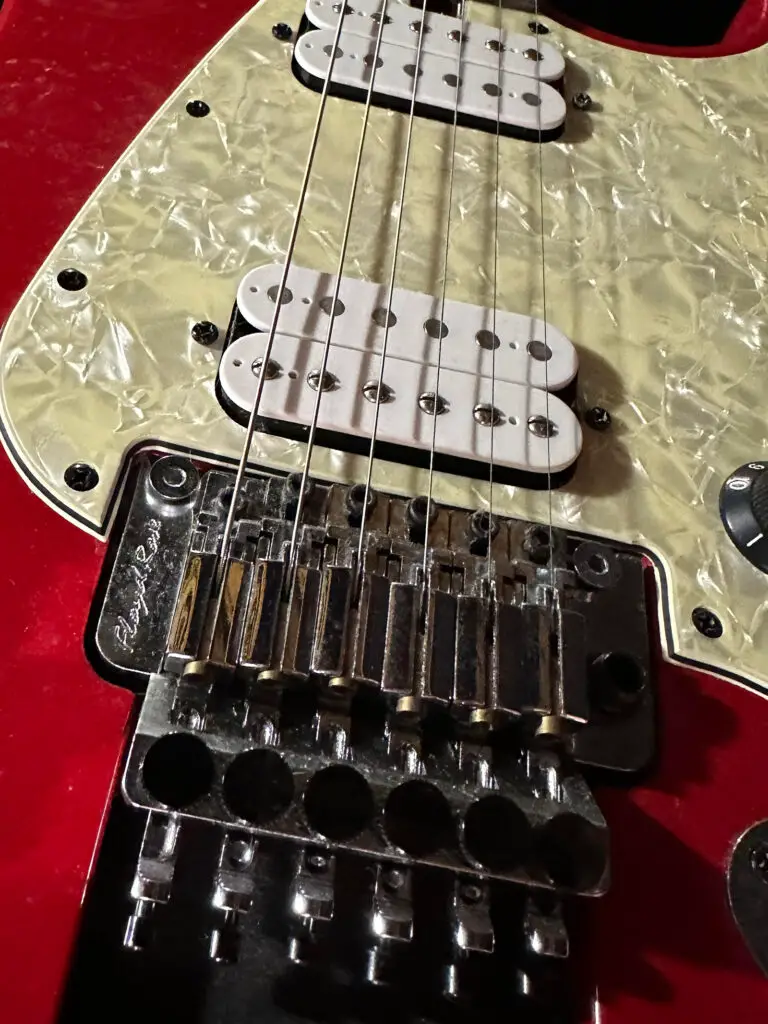
What Is A Double-Locking Tremolo?
A double-locking tremolo is a type of tremolo system that locks the guitar strings in two places: at the nut of the guitar and at the bridge. This system was designed to improve tuning stability, especially when the tremolo (or “whammy bar”) is used for wide, dramatic pitch bends.
Here’s how it works:
- Locking at the Nut: In a double locking system, the guitar’s nut has locking mechanisms, usually in the form of small clamps that can be tightened and loosened with an Allen key. When the strings are locked at the nut, it prevents them from moving in their slots, which can cause the guitar to go out of tune.
- Locking at the Bridge: The strings are also locked at the bridge. On a Floyd Rose system, for example, the strings are clamped down into the bridge saddles. This prevents any slippage at the bridge end when the tremolo is used.
- Fine Tuners: Because the strings are locked down at both ends, the traditional tuning pegs can’t be used for tuning once the nut is locked. Instead, double-locking systems have fine tuners located on the bridge itself, which allow for precise tuning adjustments.
The most notable example of a double-locking tremolo system is the Floyd Rose, which is a popular choice for many rock and metal guitarists due to its ability to maintain tuning even with aggressive tremolo use.
These systems can be more complex to set up and maintain, and changing strings can be more involved compared to non-locking systems.
What Is A Hardtail Bridge?
Hardtail bridge is another name for a fixed bridge.
A hardtail bridge is a type of guitar bridge that is fixed to the body of the guitar and does not move, unlike a tremolo bridge that allows for pitch manipulation.
The term “hardtail” is often used to refer to electric guitars that do not have a vibrato system, and the bridge is typically a simple design where the strings are anchored directly to the bridge, which is itself securely attached to the body of the guitar.
This design provides a solid coupling between the strings and the body of the guitar, which can enhance sustain and harmonic response.
Hardtail bridges are well-regarded for their tuning stability, as there are fewer variables that can cause the strings to go out of tune compared to a tremolo bridge. They also tend to be simpler to set up and maintain, as there are fewer moving parts.
One well-known example of a guitar with a hardtail bridge is the Fender Telecaster.
While Stratocasters often come equipped with a tremolo bridge, hardtail versions are also available and are sometimes preferred by players looking for the Stratocaster sound with added tuning stability.
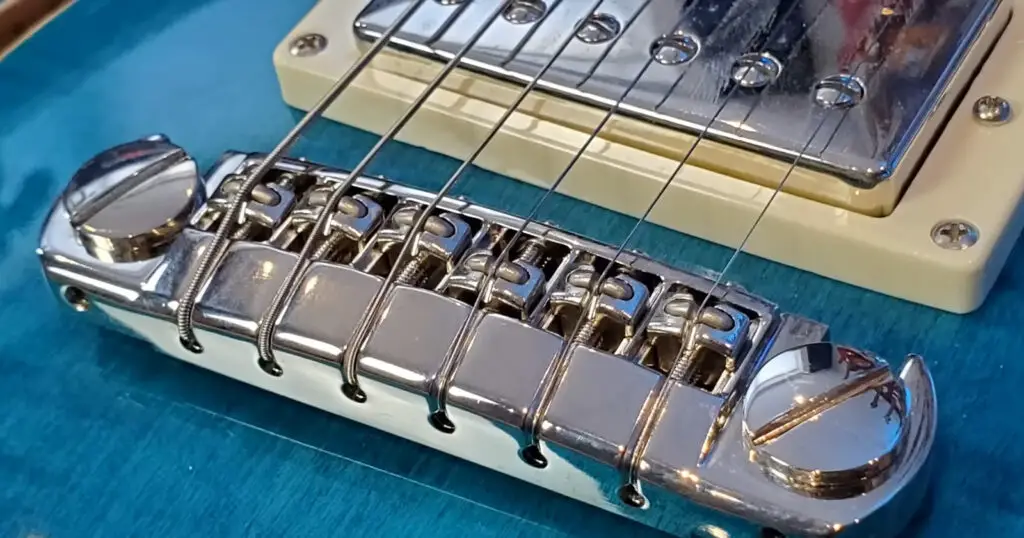
What Is A Piezo Bridge?
A piezo bridge is a type of guitar bridge that incorporates piezoelectric pickups. These pickups are different from the magnetic pickups commonly found on electric guitars.
Piezoelectric pickups work on the principle of piezoelectricity, where pressure is converted into an electrical signal. When the strings of a guitar vibrate, they apply pressure to the piezo elements in the bridge, which then generate an electrical signal that can be amplified and output as sound.
On electric guitars, a piezo bridge can be used to provide an “acoustic-like” sound, broadening the range of tones the guitar can produce.
Some electric guitars come equipped with both magnetic and piezo pickups, allowing the player to switch between or blend the two different tones.
One of the most well-known brands producing piezo bridge systems for electric guitars is LR Baggs, which makes the T-Bridge and X-Bridge products. Other brands like Fishman also produce similar systems.
Does A Guitar Need A Bridge?
A guitar needs a bridge. The bridge is a critical component of the guitar. It serves several important functions:
- String Support: The bridge holds the strings in place, raising them off the body of the guitar at the correct angle. This allows the strings to vibrate freely when plucked or strummed.
- Tuning Stability: The bridge helps to maintain the tuning stability of the guitar. On electric guitars, the bridge often includes adjustable saddles that allow the intonation of each string to be finely tuned.
- Vibration Transfer: The bridge transfers the vibrations of the strings to the guitar’s soundboard (on an acoustic guitar) or through the body (on an electric guitar). This is crucial for the guitar to produce sound.
- Action Adjustment: The bridge (or parts of it) can often be adjusted up or down to change the action or the height of the strings above the fretboard. This can affect both the playability of the guitar and the tone it produces.
Without a bridge, a guitar would not be able to function properly. The strings would have no anchor point, the guitar would struggle to produce sound, and it would be virtually impossible to play.
What Happens If Guitar Bridge Is Broken?
If a guitar bridge is broken, several problems can occur that will affect the playability and sound of the guitar:
- Loss of Action Control: The action (the height of the strings from the fretboard) may become too high or too low, making the guitar difficult to play. High action can cause discomfort or difficulty when pressing the strings down, while low action can cause buzzing noises when the strings vibrate against the frets.
- Intonation Problems: The bridge plays a crucial role in maintaining proper intonation, which is the guitar’s ability to stay in tune across the entire length of the fretboard. If the bridge is broken, the intonation can be off, causing the guitar to sound out of tune even when the open strings are correctly tuned.
- Tuning Instability: A broken bridge can cause the guitar to go out of tune quickly and frequently, as the stable anchor point for the strings is compromised.
- Loss of Sound: For acoustic guitars, the bridge transfers the string vibrations to the soundboard, which is essential for producing sound. If the bridge is broken, the guitar may produce little to no sound. For electric guitars, the impact may not be as severe, but the tonal quality can be significantly affected.
- Potential Damage to the Guitar: If the bridge is partially detached or completely broken off, it can potentially damage the guitar’s body, especially in the case of acoustic guitars. This is due to the high tension of the strings pulling on the bridge.
If your guitar bridge is broken, it’s recommended to take it to a professional for repair. Attempting to repair a broken bridge without the proper knowledge and tools can cause further damage.
Conclusion
The guitar bridge, while often overlooked, is an integral component that significantly impacts the sound, playability, and overall functionality of a guitar.
From the simplicity of the hardtail bridge to the mechanical complexity of the Floyd Rose or EverTune systems, the variety of bridges available caters to a wide range of musical needs and styles.
Understanding the different types of guitar bridges and their unique features not only deepens your knowledge of the instrument but also enables you to make more informed choices when buying a new guitar or modifying your current one.
Whether you’re after the perfect pitch-bending capabilities, the rich tonal characteristics of a piezo system, or the dependable tuning stability of a fixed bridge, there’s a guitar bridge designed to meet your needs.
As with many aspects of music, choosing the right bridge often comes down to personal preference and the style of music you wish to play. So, don’t be afraid to experiment and discover what works best for you.

